Mike
Today was a probably the slowest day at COP23, for me. Our group met with one of the former head State Department negotiating team lawyers, Sue Biniaz, and UNFCCC negotiations scholar Dan Bodansky. It was interesting to hear Sue’s insights on the near catastrophic fate of the Paris Agreement, which came down to a single word (“shall” vs. “should”), in the context of the legally binding nature of nationally determined contributions. Afterwards, I attended a side event for my client that focused on financing climate mitigation and adaptation in Eastern and Southern Africa. The day ended on a high note, as I was invited to join my client for a meeting between the US Delegation and senior business leaders. Because the conversation was off the record, I can’t share much, but it was interesting to listen to the new Administration’s perspective on issues that we’ve both discussed in class and witnessed here at COP23.
Sarah
I was with Mike and the group to meet with the former State Department principal lawyer on the climate change negotiations, Sue Biniaz, and professor Dan Bodansky. It was interesting to hear what they thought of subnational action at the COP. They agreed that the current question is whether subnational action is a blip or if (due to politics and other factors) it will continue to grow in importance in the next few years.
I next covered an event on subnational action and the ways in which the private sector is involved. I think one of my key takeaways from the discussion was how different every state has approached this, and one of the challenges states face now is making their approach accessible to other states.
Finally, I attended a client dinner with the subnational delegation. It was one of my favorite parts of this COP because I could ask the delegates questions about their experiences and take-aways.
Tim
Things were winding down today. I attended the BINGO meeting in the morning in the hopes of connecting with a representative from a company that I’ll be working with as part of a class, but unfortunately he wasn’t at the meeting. Our class them met with Susan Biniaz and Dan Bodansky and got their perspective on how COP23 compares to the past COPs that they have attended and participated in. They classified COP23 as a ‘minor COP’, given the fact that the negotiations this year are largely in preparation of the 2018 facilitative dialogue. The rest of my day was spent at talks in the U.S. Climate Action Center, and many of them hit the same talking points that I’d already heard a number of times before: subnational actors in the U.S. are committed to climate action and remaining engaged in climate negotiations, and businesses and economies will be able to remain profitable and grow while decreasing their GHG emissions.
Laurel (Day 10):
Today was an oddly quiet day, only a handful of side events were going on in the Bonn Zone, but I spent the day in the Bula Zone-where the negotiations are taking place.There was a noticeable calm and quiet. Most working groups and informal consultations to the parties had concluded and many country representatives have left the conference already, leaving just a few (heads of delegations) at the COP. Groups have submitted their final draft documents which are then translated, proof-read and then published online at the unfccc website. The drafts however must be formally accepted into the final COP document.
This final acceptance happens at the Closing Plenary COP and CMP session led by the COP Presidency (Fijian Prime Minister), who went through the formal adoption and acceptance of these drafts, roughly: “Agenda Item XX, draft decision XX has been proposed, if there are no objections <pause> then it is decided”.
Because the last two weeks have been filled with negotiations within the working groups regarding specific articles, there were no objections to the drafts proposed. However, the items that still have not found consensus (including the APA) were ‘skipped over’, and negotiations continue. This is also another reason why there are fewer people walking from place-to-place as delegations are probably holed up in their country offices.
The COP plenary will resume sometime this evening, once agreements have been reached. However, as of 6pm nothing has appeared on the conference schedule. A NGO representative suggested this will realistically happen closer to 9 or 10pm, but wouldn’t be surprised if the waiting lasted even longer. It is not uncommon for the final draft documents to appear and subsequent final plenary to be held in the wee hours of Saturday morning…and so we wait.
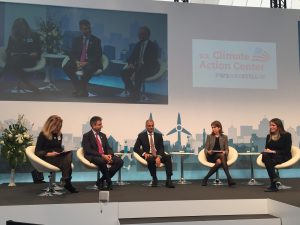 and presentations from business leaders across several sectors, ranging from banks and investment groups (like Bank of America and JP Morgan) to retailers (like Microsoft and Target). These senior leaders came to COP23 to show their support for the emissions reductions targets that underpin the Paris Agreement. They also came to tout their progress in reaching their company’s own emission reductions milestones. One of my favorite panels was “Capital for Decarbonizing,” which featured executives from financial services companies discussing how to finance the transition to a low carbon future. One of the panelists, Val Smith, Citi Bank’s Global Head of Corporate Sustainability, discussed the compan
and presentations from business leaders across several sectors, ranging from banks and investment groups (like Bank of America and JP Morgan) to retailers (like Microsoft and Target). These senior leaders came to COP23 to show their support for the emissions reductions targets that underpin the Paris Agreement. They also came to tout their progress in reaching their company’s own emission reductions milestones. One of my favorite panels was “Capital for Decarbonizing,” which featured executives from financial services companies discussing how to finance the transition to a low carbon future. One of the panelists, Val Smith, Citi Bank’s Global Head of Corporate Sustainability, discussed the compan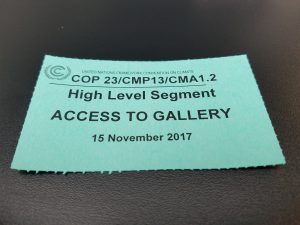
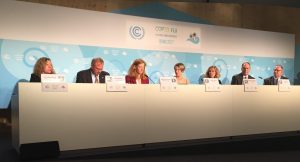
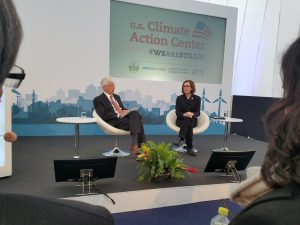
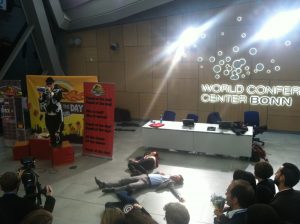
 Week 2 of COP23 kicked off with a fresh group of Duke students in attendance. The first day of is typically spent figuring out logistics and getting familiar with the layout of the conference center. The students were able to easily navigate to the COP and quickly found themselves in a variety of different side events and negotiating sessions throughout the day. Here are their first day updates:
Week 2 of COP23 kicked off with a fresh group of Duke students in attendance. The first day of is typically spent figuring out logistics and getting familiar with the layout of the conference center. The students were able to easily navigate to the COP and quickly found themselves in a variety of different side events and negotiating sessions throughout the day. Here are their first day updates:
